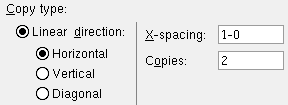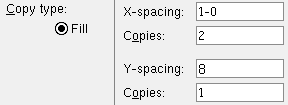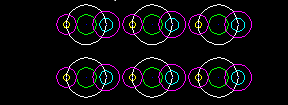 Copy Objects ( Drawing Editor )
Copy Objects ( Drawing Editor )
Tool summary :
Also see :
- Drawing Editor (where Copy Objects is a tool)
- Show ( Copy Objects acts on layers marked " Show ")
- Layer Panel (selects default layer copy is made to)
- Unshorten (before using Copy Objects )
- Member Copy (a similar tool in Modeling )
- Add Bevel Symbol (has Repeat mouse binding for fast copying)
- Bolt Add (has Repeat mouse binding for fast copying)
- Weld Add (has Repeat mouse binding for fast copying)
- Add Standard Detail (a way to copy from different files)
- Undo (undoes Copy Objects )
page 1 | contents | edit > | edit -- area mode
 Copy Objects , Single :
Copy Objects , Single :
An example of Copy Objects with ' Single ' selected as the " Copy type ."
|
1 . Select the objects you want to copy, then invoke Copy Objects . | |||
|
2 . Select ' Single ' as the " Copy type ," optionally set a " Rotation " or " Mirror image ." | |||
|
3 . Left-click ( Locate ) to locate a reference point . | |||
|
4 . Left-click ( Locate ) to locate a second point . | |||
|
5 . Right-click ( Return ) when done placing copies. | |||
|
6 . The objects have been copied. |
page 1 | contents | edit > | edit -- area mode | top
 Copy Objects , Linear direction :
Copy Objects , Linear direction :
An example of Copy Objects with ' Linear direction ' selected as the " Copy type " and ' Horizontal ' selected as the " Linear direction ."
|
1 . Select the objects you want to copy, then invoke Copy Objects . | |||
|
2 . Select ' Linear direction ' as the " Copy type ," then select a " Linear direction " and enter the spacing and the number of copies. | |||
|
3 . The originally selected objects have been copied twice, horizontally to the right. |
page 1 | contents | edit > | edit -- area mode | top
 Copy Objects , Fill :
Copy Objects , Fill :
An example of Copy Objects with ' Fill ' selected as the " Copy type ."
|
1 . Select the objects you want to copy, then invoke Copy Objects . | |||
|
2 . Select ' Fill ' as the " Copy type ," then enter the spacing and number of copies in the X and Y directions. | |||
|
3 . Five new copies are made of the originally selected objects. |
page 1 | contents | edit > | edit -- area mode | top
 Step-by-step instructions :
Step-by-step instructions :
The following instructions assume that you are using a 3-button mouse. You must do either step 1e (preselection) or step 3 (in-tool selection) to perform this operation.
1a : Use the Layer Panel to show the layers on your current Drawing Editor drawing that you want to copy to and graphics for copying from.
1b (optional) : On the Layer Panel, select the layer that you want to copy the selected graphics to. This step is optional because you can change the drawing layer in step 4.
1c (if applicable) : To ensure accuracy of measurement, first Unshorten the drawing (if it has been Shortened ).
1d (optional) : Set selection filter(s) for the type(s) of objects that you want to copy.


Select Items bindings (step 1e) 1e (optional) : Draw an area box to select the object(s) that you want to copy. Use Select- if you want to deselect objects. Use Select + to select additional objects.
2 . Invoke Copy Objects using any one (1) of the following methods:
Method 1 : Click the Copy Objects icon. The icon can be taken from the group named ' Edit -- Area Mode ' and placed on a toolbar (classic) or the ribbon (lightning).
Method 2 : If " Drawing Editor layout style " is ' Classic ', you can use the menu system to choose Edit > Copy Objects .
Method 3, 4 or 5 : Copy Objects can also be invoked using a keyboard shortcut , the context menu , or a mode . For the ' Lightning ' layout style, configuration of the interface is done using Customize Interface .
Method 6 : With Area Mode mouse bindings active, middle-click ( Copy ).
3 . Skip this step if you already selected objects in step 1e.
|
|
|
Select Items bindings |
3a (if you didn't preselect) : Copy Objects prompts you to use Select Item(s) mode bindings to select one or more members or materials, or draw an area box (
), or use the Model Tree (
). Press the Enter key or right-click ( Menu ) and choose " OK " on the context menu when you are done selecting objects.
4 . The Copy Objects window opens. Select the " Copy type " before making other choices on the window.
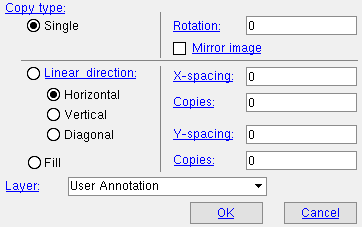
Copy type: Single or Linear direction or Fill . ' Single ' generates a single copy of the selected Drawing Editor objects (see the example ). ' Linear direction ' generates multiple copies of the selected objects (see the example ). ' Fill ' generates multiple copies of the selected objects (as many copies as are necessary) to fill a space (see the example ).
Linear direction: Horizontal or Vertical or Diagonal . This applies when ' Linear ' is the " Copy type ." Select ' Horizontal ' to copy horizontally along the X screen axis , with options for " Y-spacing " and " Copies ." Select ' Vertical ' to copy vertically, with options for " X-spacing " and " Copies ." Choose ' Diagonal ' to copy diagonally, with options for " X-spacing ," " Y-spacing " and " Copies ."
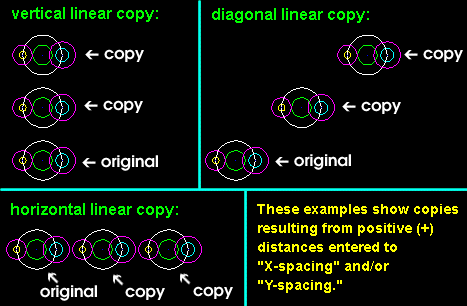
Rotation: Any positive or negative angle from 360 to -360 degrees. ' 0 ' is no rotation, a ' positive number ' rotates the image counter clockwise, a ' negative number ' rotates the image clockwise. This applies when ' Single ' is the " Copy type ."
Mirror image:
or
. Mirroring can be done when ' Single ' is the " Copy type ." If this box is checked (
), the image is copied as a mirror image of itself. A mirror image is one in which right and left are reversed. If this box is not checked (
) the image will not be mirrored.
X-spacing: The spacing (+/- distance) between copies along the X screen axis . A ' positive distance ' adds copies to the right of the objects selected to be copied, a ' negative (-) distance ' adds copies to the left. This applies when ' Fill ' is the " Copy type " or when ' Diagonal ' or ' Horizontal ' is the " Linear copy direction ."
Copies: The number ( 1 or 2 or 3 ...) of times horizontal you want the " X-spacing " to be duplicated.
Y-spacing: The spacing (+/- distance) between copies along the Y screen axis . A ' positive distance ' adds copies above the objects selected to be copied, a ' negative (-) distance ' adds copies below the objects selected to be copied. This applies when ' Fill ' is the " Copy type " or when ' Diagonal ' or ' Vertical ' is the " Linear copy direction ."
Copies: The number ( 1 or 2 or 3 ...) of times vertical you want the " Y-spacing " to be duplicated.
Layer: The drawing layer that the copied objects will be drawn on after you press " OK " to close this window. If that layer happens to be hidden (not marked " Show "), the copies will not be visible until you check the box to "
Show " the hidden layer. The default selection made here is the layer that was selected on the Layer Panel before you began this operation.
Alternative 1 : Press " OK " to continue. Go to step 7 if you are doing a ' Linear ' or ' Fill ' copy. Go to step 5 if you are doing a ' Single ' copy.
Alternative 2 : Press " Cancel " (or the Esc key or the
button) to end the Copy Objects operation. Do not continue.
5 . Go to step 7 if you are doing a ' Linear ' or ' Fill ' copy. If, in step 4, you selected ' Single ' as the " Copy type ," the status line reads, "Locate a reference point" and all to-be-copied objects are highlighted. Locate- Pan -Return mouse bindings become active along with various Locate options.
|
|
|
bindings |
5a : Place the point location target where you want the reference point (for instance, on an exact point on one of the to-be-copied items), then left-click ( Locate ).
6 . The status line prompts, "Locate second point."
|
|
|
bindings |
Alternative 1 : Position the point location target to where you want the copy of the objects to be placed with respect to the reference point, then left-click ( Locate ). The copy is performed, and the screen redraws to show the newly copied objects (unless they were copied to a hidden layer). Either repeat this step to place other copies or right-click ( Return ) if you are done.
Alternative 2 : Right-click ( Return ) to end the ' Single ' copy operation without placing any more copies. Go to step 7.
7 . The copy operation is done. The mouse bindings that were active before you invoked Copy Objects are again active. All copied items are placed on whatever layer was selected on the Copy Objects window.
Possibility 1 : For a ' Single ' copy, one or more copies of the objects selected in step 1e (or step 3 if you didn't pre-select) are placed exactly the distance that the point(s) you located in step 6 are from the reference point you located in step 5 .
Possibility 2 : If you did a ' Linear ' copy, the objects selected in step 1e (or step 3 if you didn't pre-select) are duplicated horizontally, vertically or diagonally on the screen.
Possibility 3 : If you did a ' Fill ' copy, an area on the screen is filled with copies of the objects you selected in step 1e (or step 3 if you didn't pre-select).
Note: At this point you can still undo your changes by using Revert or Undo . If you Save to make your changes permanent, you will no longer be able to Revert , but you can still Undo . For an ' Single ' copy operation, Undo undoes each copy you made, one at a time.
page 1 | contents | edit > | edit -- area mode | top







